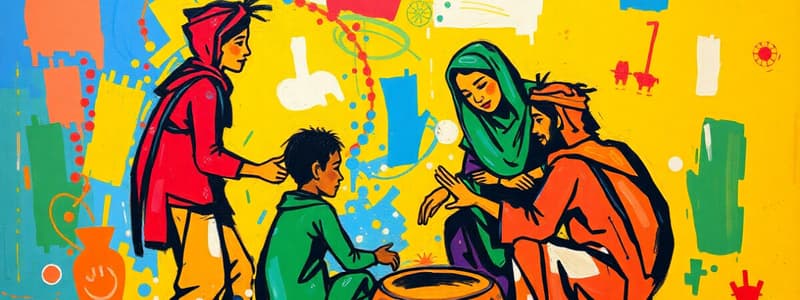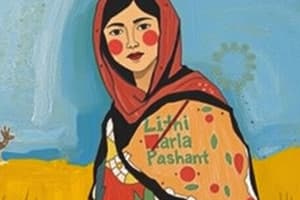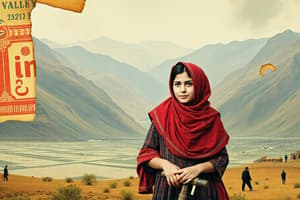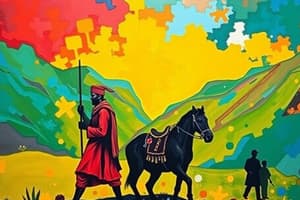Podcast
Questions and Answers
Malala's namesake, Malalai of Maiwand, is described as inspiring 'her countrymen with her courage'. Considering the nuances of Pashtun culture and the historical context implied, what is the most sophisticated interpretation of 'courage' in this specific context?
Malala's namesake, Malalai of Maiwand, is described as inspiring 'her countrymen with her courage'. Considering the nuances of Pashtun culture and the historical context implied, what is the most sophisticated interpretation of 'courage' in this specific context?
- Moral fortitude to uphold Pashtunwali values in the face of societal pressure and external threats, potentially including intellectual and verbal defiance. (correct)
- Resilience in the face of personal hardship and loss, maintaining composure and dignity amidst adversity and societal upheaval.
- Strategic military leadership, inspiring troops through tactical prowess and battlefield command during periods of conflict.
- Physical bravery demonstrated in direct combat against invading forces, exemplified by wielding a weapon on the battlefield.
Malala invokes Newton's Third Law to describe her interactions with Khushal. Analyzing this analogy beyond its literal interpretation, what deeper insight does it reveal about Malala's approach to conflict and interpersonal dynamics within her familial context?
Malala invokes Newton's Third Law to describe her interactions with Khushal. Analyzing this analogy beyond its literal interpretation, what deeper insight does it reveal about Malala's approach to conflict and interpersonal dynamics within her familial context?
- It suggests a passive acceptance of Khushal's aggression, implying a deterministic view where her reactions are merely unavoidable consequences of his actions.
- It highlights a scientific and detached perspective on family disputes, minimizing the emotional impact of sibling rivalry by framing it within a mechanistic framework.
- It demonstrates a sophisticated understanding of cause and effect in social interactions, suggesting a calculated and strategic response to provocation rather than uncontrolled emotional reaction. (correct)
- It underscores a fatalistic acceptance of familial discord as an immutable force, akin to a natural law governing interpersonal relationships, precluding the possibility of proactive conflict resolution.
The text mentions games like 'Mango, Mango' and 'Chindakh (Frog)'. Considering the limited descriptive detail provided, what is the most plausible inference regarding the cultural significance of these games within the children's lives?
The text mentions games like 'Mango, Mango' and 'Chindakh (Frog)'. Considering the limited descriptive detail provided, what is the most plausible inference regarding the cultural significance of these games within the children's lives?
- They are predominantly influenced by Western entertainment and globalization, reflecting a departure from traditional Pashtun games and a homogenization of childhood play.
- They primarily serve as a means of unstructured physical activity, devoid of any deeper cultural or symbolic meaning beyond simple recreation and childhood amusement.
- They are spontaneous improvisations based on readily available resources and immediate environments, lacking any formal structure or connection to established cultural heritage.
- They represent codified cultural practices transmitted through generations, embodying implicit social norms and traditional Pashtun values through playful engagement. (correct)
The act of creating a cricket ball from 'an old sock stuffed with rubbish' and wickets 'drawn on the wall in chalk' exemplifies resourcefulness. However, within the broader socio-economic context implicitly suggested, what is the most critical underlying implication of this practice?
The act of creating a cricket ball from 'an old sock stuffed with rubbish' and wickets 'drawn on the wall in chalk' exemplifies resourcefulness. However, within the broader socio-economic context implicitly suggested, what is the most critical underlying implication of this practice?
Atal's act of 'grabbing the neighbors' ball' and his subsequent 'cheeky grin' and 'shrug' present a complex picture of childhood morality. From a developmental psychology perspective, which of the following best encapsulates the nuanced understanding of Atal's behavior?
Atal's act of 'grabbing the neighbors' ball' and his subsequent 'cheeky grin' and 'shrug' present a complex picture of childhood morality. From a developmental psychology perspective, which of the following best encapsulates the nuanced understanding of Atal's behavior?
Malala's coded communication with Safina through 'two taps' and a 'hole between our houses' represents a form of covert social interaction. Considering the potential societal norms and constraints implicitly present in the described setting, what is the most probable underlying motivation for this clandestine mode of communication?
Malala's coded communication with Safina through 'two taps' and a 'hole between our houses' represents a form of covert social interaction. Considering the potential societal norms and constraints implicitly present in the described setting, what is the most probable underlying motivation for this clandestine mode of communication?
Malala's statement, 'Most of them are not as civilized as girls,' when referring to boys, should be interpreted with critical nuance. Which of the following analyses most accurately captures the complexity and potential subtext of this seemingly simple observation?
Malala's statement, 'Most of them are not as civilized as girls,' when referring to boys, should be interpreted with critical nuance. Which of the following analyses most accurately captures the complexity and potential subtext of this seemingly simple observation?
The description of Swat Valley as 'known for its beauty...tall mountains, lush green hills, and crystal-clear rivers' serves a specific narrative purpose in the opening paragraph. Beyond mere scene-setting, what is the most profound rhetorical function of this idyllic portrayal?
The description of Swat Valley as 'known for its beauty...tall mountains, lush green hills, and crystal-clear rivers' serves a specific narrative purpose in the opening paragraph. Beyond mere scene-setting, what is the most profound rhetorical function of this idyllic portrayal?
Malala's 'little talk with God' about her brothers, expressing their 'inconvenience' but ultimately making 'peace with these brothers', reveals a complex spiritual and emotional negotiation. What is the most nuanced interpretation of this interaction with the divine?
Malala's 'little talk with God' about her brothers, expressing their 'inconvenience' but ultimately making 'peace with these brothers', reveals a complex spiritual and emotional negotiation. What is the most nuanced interpretation of this interaction with the divine?
The phrase 'As Free as a Bird' as a section title, juxtaposed with the descriptions of childhood games and domestic life, creates a subtle thematic tension. Considering the broader context of potential future restrictions on freedom (implied, but not explicitly stated), what is the most sophisticated understanding of this title's irony and narrative foreshadowing?
The phrase 'As Free as a Bird' as a section title, juxtaposed with the descriptions of childhood games and domestic life, creates a subtle thematic tension. Considering the broader context of potential future restrictions on freedom (implied, but not explicitly stated), what is the most sophisticated understanding of this title's irony and narrative foreshadowing?
Flashcards
Pashtun
Pashtun
A member of a proud tribe found in Afghanistan and Pakistan.
Swat Valley
Swat Valley
A scenic region in northwest Pakistan known for its beauty.
Malalai
Malalai
A young Pashtun heroine known for her courage.
Khushal
Khushal
Signup and view all the flashcards
Atal
Atal
Signup and view all the flashcards
Cricket
Cricket
Signup and view all the flashcards
Alley games
Alley games
Signup and view all the flashcards
Cheeky grin
Cheeky grin
Signup and view all the flashcards
Code tapping
Code tapping
Signup and view all the flashcards
Childhood memories
Childhood memories
Signup and view all the flashcards
Study Notes
Childhood in Pakistan
- The author grew up in Mingora, Swat Valley, northwest Pakistan
- The author's family is Pashtun
- The author's father (Ziauddin) and mother (Toor Pekai) are from mountain villages
- The area is known for its beauty, lush green hills, and clear rivers
- The author's name honors a Pashtun heroine
Family Dynamics
-
The author has a ten-year-old brother (Atal) and a fourteen-year-old brother (Khushal)
-
The author and her brothers have disputes
-
They argue over the TV remote, chores, and academic performance
-
The brothers annoy the author, but Atal annoys her less than Khushal
-
The author and her brothers sometimes have disagreements about rules and fairness
Childhood Games
- They played cricket day and night in the alley—sometimes on the roof of their house
- They improvised cricket balls from old socks and other things
- They played games like tag, another game called Mango, Mango, and hopscotch called Chindakh
- Thief and police is a game they also play
- Sometimes, the youngest brother is sent to fetch a ball
Communication with Neighbors
- There's a technique used to communicate with neighbors
- Two taps on the wall is a code between the author and her neighbor
- The author slips aside a brick to create a hole between the houses
- They whisper back and forth sometimes going back and forth to the neighbor's house
Observations about Boys
- Many boys are not as civilized as girls
Studying That Suits You
Use AI to generate personalized quizzes and flashcards to suit your learning preferences.




